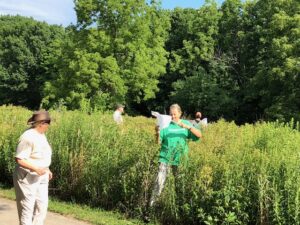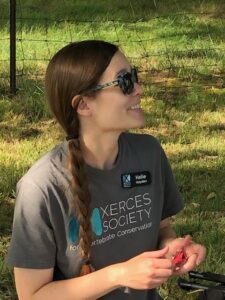Missouri Bumble Bee Atlas Training at CANS
by Bill Mees, Nature Areas Committee
Science always starts with a question. Scientists then design a study to find the answer. How many bumble bee species reside in Missouri? How are they distributed across the state? Are populations stable, increasing, or decreasing?
These and other questions will be answered by the Missouri Bumble Bee Atlas. The MBBA will assist natural resource professionals, land and area managers, and policy makers refine current bumble bee conservation practices using evidence-based recommendations.
The MBBA is a study being led by the Xerces Society in cooperation with MDC, MU CAFNR, and Pheasants Forever/Quail Forever and volunteers like you.
Saturday, July 30 was a gorgeous day – moderate temperatures, sunny, gentle breeze – perfect for not only volunteers but more importantly for bumblebees.
Seventeen volunteer citizen scientists gathered at Columbia Audubon Nature Sanctuary for a training session led by Kellie Hayden, the Xerces Society Bumble bee technician.
Participants learned about bumble bees in general. Did you know, there may be up to 11 bumble bee species in Missouri? Unfortunately, one of those, the rusty patch bumble bee, is probably no longer a Missouri resident. The scientists-in-training learned how to identify the species and gender. One useful piece of information to know is females can sting, but males lack stingers.
Each captured bee is placed in a capped vial. The vial is kept in ice so the bee enters a stupor which allows handling. Up to five photos are taken of each bee. The photos allow the real experts to corroborate the species identification assigned in the field.
Missouri has been divided into 75 grids, 42×42 miles each. Volunteers register for one of the grids for collection and reporting. In addition to the bees’ species and gender, the flower the bee was on, the immediate habitat as well as neighboring habitat are also documented.
CANS was selected for the training event specifically because of its prairie. Prairies are prime habitat for many different species of pollinators. The trainees were able to wade into the prairie and test their new skills. In a short 30-40 minutes in the prairie, they netted 3 bumble bee species as well as a number of carpenter bees. Carpenter bees look similar to bumble bees, but aren’t.
The Xerces Society plans to return to Columbia next year to recruit and train more volunteers. CANS Is the perfect training site for the Missouri Bumble Bee Atlas. This is another (and unexpected) educational use for CANS.


